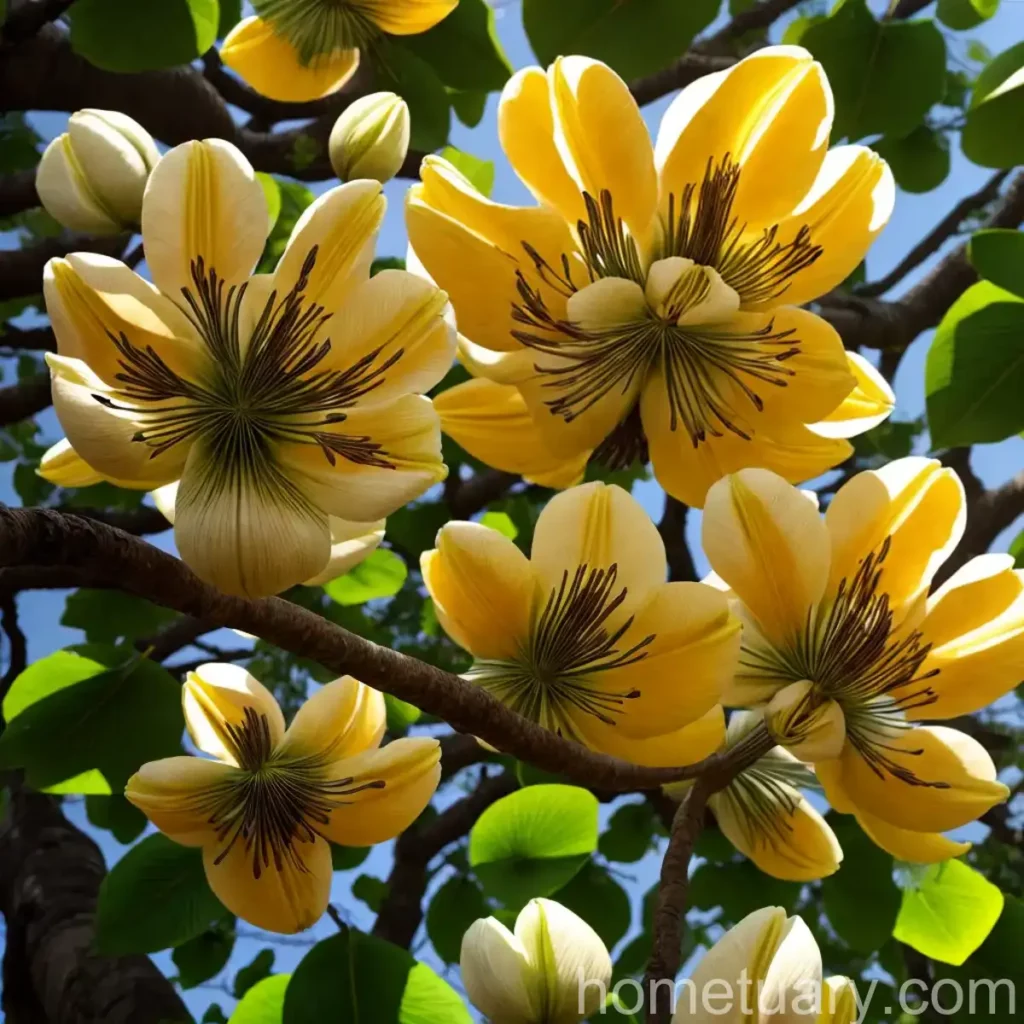Chinese Tulip Tree (Liriodendron chinense) – A Comprehensive Plant Guide
Introduction
Liriodendron chinense, commonly known as the Chinese tulip tree, is a magnificent ornamental tree that boasts beautiful flowers and unique foliage. It is a member of the Magnoliaceae family and closely related to the American tulip tree, Liriodendron tulipifera. The Chinese tulip tree is native to Eastern Asia, particularly China, and is prized for its aesthetic appeal and cultural significance.
In this comprehensive guide, we will delve into the characteristics, cultivation, maintenance, and uses of the Chinese tulip tree. Whether you are a novice gardener or an experienced horticulturist, this guide will provide you with valuable insights into harnessing the full potential of this stunning tree in your garden or landscape.
Chinese Tulip Tree Characteristics
The Chinese tulip tree (Liriodendron chinense) is renowned for its distinctive features, making it an alluring addition to any landscape. Let’s explore some key characteristics of this fascinating tree:
-
Height: Mature Chinese tulip trees can reach heights of 50 to 80 feet, making them a striking presence in any garden or park.
-
Flowers: The tree produces large, tulip-shaped flowers that typically appear in late spring or early summer. The blossoms exhibit a delightful blend of green, yellow, and orange hues, creating a visually captivating display.
-
Leaves: The foliage of the Chinese tulip tree is characterized by large, lobed leaves that bear a resemblance to tulip flowers, hence the common name. The leaves turn a vibrant golden-yellow in the fall, adding a splash of color to the autumn landscape.
-
Habitat: In its natural habitat, the Chinese tulip tree thrives in well-drained soils and favors locations with ample sunlight.
Liriodendron Chinense Tree Facts
Taxonomy and Nomenclature
The Chinese tulip tree, scientifically known as Liriodendron chinense, belongs to the genus Liriodendron, which is part of the Magnoliaceae family. The genus name “Liriodendron” is derived from the Greek words “lirion” (lily) and “dendron” (tree), reflecting the lily-like appearance of its flowers and the tree’s overall size and stature.
Native Distribution
The Chinese tulip tree is indigenous to China and other regions of Eastern Asia. It thrives in areas with temperate climates, where it can be found growing in mixed forests and alongside riverbanks.
Geographic Adaptability
Liriodendron chinense is known for its adaptability to a range of soil types and climatic conditions. It can flourish in both urban and rural settings, making it a versatile choice for landscaping projects.
Chinese Tulip Tree Planting Guide
Cultivation and Planting
Soil Requirements
The Chinese tulip tree thrives in well-drained, fertile soils. It prefers slightly acidic to neutral soil pH levels (pH 6.0-7.5) and is adaptable to various soil textures, including loamy, sandy, and clay soils. When planting, ensure that the soil is rich in organic matter and provides good drainage to promote healthy root development.
Sunlight Exposure
Full sun exposure is ideal for the Chinese tulip tree. Select a planting site that receives at least 6-8 hours of direct sunlight daily to encourage robust growth and prolific flowering. Avoid shaded or heavily shaded areas, as inadequate sunlight can diminish the tree’s overall vigor and flowering potential.
Watering Needs
During the establishment phase, newly planted Chinese tulip trees require regular watering to support root establishment. Once established, the tree is moderately drought-tolerant, but it will benefit from supplemental watering during prolonged dry spells, particularly in the summer months.
Planting Considerations
When planting a Chinese tulip tree, consider the following guidelines for optimal establishment and growth:
-
Spacing: Provide ample space for the tree to reach its mature dimensions without crowding other plants or structures. Allow for a spacing of 20-30 feet between individual trees to accommodate their expansive root systems and branch spread.
-
Season: The best time to plant a Chinese tulip tree is in early spring or late fall, when the weather is cool and the tree can acclimate to its new environment without the stress of extreme temperatures.
-
Depth: Ensure that the planting hole is as deep as the root ball and two to three times wider to facilitate root expansion and establishment.
-
Mulching: Apply a layer of organic mulch around the base of the tree, keeping it several inches away from the trunk. Mulch helps to retain soil moisture, regulate soil temperature, and inhibit weed growth.
| Chinese Tulip Tree Planting Essentials |
|---|
| Soil Requirements |
| Sunlight Exposure |
| Watering Needs |
Liriodendron Chinense Care Tips
Fertilization Techniques
After planting, the Chinese tulip tree benefits from a balanced, slow-release fertilizer applied in early spring. Choose a fertilizer with a balanced NPK (nitrogen, phosphorus, potassium) ratio to promote healthy foliage growth and vibrant flowering. Follow the manufacturer’s instructions for proper application rates based on the tree’s size and age.
Pruning Techniques
Pruning is essential for shaping the tree, removing dead or damaged branches, and promoting a strong, well-structured canopy. Prune the Chinese tulip tree during the dormant season in late winter or early spring to minimize stress and sap loss. Avoid excessive pruning, as the tree naturally forms a symmetrical and attractive crown without heavy intervention.
Maintenance Schedule
Regular maintenance tasks for the Chinese tulip tree include:
-
Mulching: Renew the layer of mulch around the base of the tree annually to maintain its moisture-retaining and insulating properties.
-
Watering: Monitor soil moisture levels during dry periods and water as needed to prevent drought stress.
-
Fertilization: Apply a balanced fertilizer in early spring to support healthy growth and floral development.
-
Pruning: Conduct annual pruning to shape the tree and remove any dead or diseased wood.
| Liriodendron Chinense Care Essentials |
|---|
| Fertilization Techniques |
| Pruning Techniques |
| Maintenance Schedule |
Chinese Tulip Tree Growth Habits
The Chinese tulip tree exhibits vigorous growth under favorable conditions, establishing a strong root system and developing a well-branched canopy. Its growth habits include:
-
Moderate Growth Rate: The tree displays a moderate growth rate, adding approximately 13-24 inches of new growth per year. With proper care and favorable environmental conditions, the growth rate can be even more robust.
-
Flowering Season: The Chinese tulip tree blooms in late spring to early summer, producing an abundance of showy, tulip-shaped flowers that serve as a magnet for pollinators, including bees and butterflies.
-
Leafing Pattern: The large, lobed leaves of the Chinese tulip tree provide ample shade and create a lush, green canopy during the growing season. In the fall, the leaves turn a brilliant golden-yellow, contributing to the tree’s seasonal appeal.
Liriodendron Chinense Tree Species
Liriodendron chinense is a species of flowering tree that belongs to the magnolia family. It is closely related to the American tulip tree (Liriodendron tulipifera) and shares similar characteristics, such as the distinctive tulip-shaped flowers and large, glossy leaves. The Chinese tulip tree is valued for its ornamental qualities and is cultivated for landscape beautification and horticultural appreciation.
Chinese Tulip Tree Uses
Landscape Ornamentation
The Chinese tulip tree serves as a captivating focal point in garden landscapes, parks, and urban green spaces. Its graceful form, striking flowers, and vibrant foliage make it a sought-after choice for enhancing outdoor environments.
Shade and Shelter
The broad, symmetrical canopy of the Chinese tulip tree provides ample shade, making it a welcoming retreat during hot summer days. Its dense foliage also serves as a haven for birds and other small wildlife.
Educational and Scientific Study
Liriodendron chinense is of interest to botanists, horticulturists, and researchers due to its unique botanical features and ecological importance. The tree’s cultivation and conservation contribute to ongoing studies and conservation efforts related to biodiversity and environmental sustainability.
| Chinese Tulip Tree Uses |
|---|
| Landscape Ornamentation |
| Shade and Shelter |
| Educational and Scientific Study |
Chinese Tulip Tree Diseases and Pests
Disease Resistance
The Chinese tulip tree exhibits good resistance to most common plant diseases, including leaf spot, powdery mildew, and canker diseases. However, it is important to monitor the tree for any signs of stress or decline, as environmental factors and cultural practices can affect its overall health and vigor.
Pest Management
While relatively pest-resistant, the Chinese tulip tree may occasionally encounter pest issues such as aphids, scale insects, and tuliptree aphid (Illinoia liriodendri). Regular inspection and proactive pest management strategies, including natural predators and horticultural oils, can help maintain the tree’s vitality and minimize pest-related damage.
Botanist’s Tips
As a plant scientist with a passion for understanding and nurturing plant life, I offer the following tips for cultivating and caring for the Chinese tulip tree:
-
Soil Assessment: Before planting a Chinese tulip tree, conduct a soil test to determine its pH, nutrient content, and drainage characteristics. Amend the soil as necessary to create an optimal growing environment for the tree.
-
Environmental Considerations: Select a planting site that provides ample sunlight, good air circulation, and adequate space for the tree to grow to its full size. Consider the tree’s long-term environmental needs when planning its placement in the landscape.
-
Pruning Best Practices: When pruning the Chinese tulip tree, focus on removing dead or crossing branches to improve air circulation and shape the tree’s canopy. Avoid drastic pruning, as the tree naturally develops an attractive form with minimal intervention.
-
Integrated Pest Management: Implement integrated pest management (IPM) strategies to address potential pest issues. Encourage natural predators, such as ladybugs and lacewings, to control aphid populations and minimize the need for chemical interventions.
-
Appreciating Biodiversity: Explore the interconnectedness of plant life within the ecosystem and appreciate the Chinese tulip tree as a contributor to biodiversity, providing habitat and sustenance for various native species.
Fun Facts
Symbolism and Cultural Significance
The Chinese tulip tree holds cultural significance in its native range and is associated with themes of renewal, prosperity, and beauty. In Chinese folklore, the tree is revered for its elegance and timeless appeal, often symbolizing longevity and good fortune.
Historical Uses
In traditional Chinese medicine, various parts of the Chinese tulip tree, including the bark and leaves, have been used for their medicinal properties. The tree’s therapeutic potential and historical uses underscore its multifaceted significance.
Environmental Impact
As a native species in certain regions of Eastern Asia, the Chinese tulip tree plays a vital role in supporting local biodiversity and contributing to ecosystem health. Its presence enriches natural landscapes and provides ecological value through habitat provision and soil stabilization.
Links to External Resources
For further exploration of the Chinese tulip tree and related topics, consider the following external resources:
- Planting and Care of the Chinese Tulip Tree
- Liriodendron chinense: A Guide to Species Identification
- Chinese Tulip Tree Conservation and Biodiversity
- Botanical Illustrations and Cultivation Tips for Liriodendron chinense
- Medicinal Uses of Liriodendron chinense in Traditional Chinese Medicine
In conclusion, the Chinese tulip tree (Liriodendron chinense) stands as a testament to the beauty and resilience of nature. Its alluring blossoms, vibrant foliage, and ecological contributions make it a plant of immense horticultural and environmental value. By understanding its characteristics, cultural significance, and ecological role, we can cultivate a deeper appreciation for the Chinese tulip tree and its place within the natural world.















